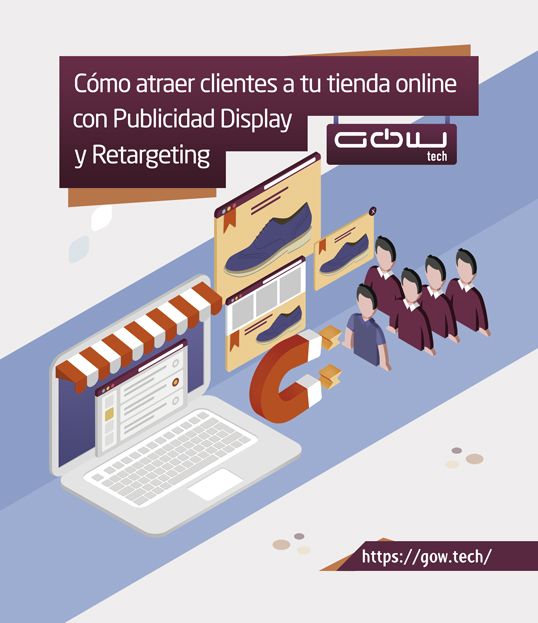From Gowtech we want to help you increase traffic on your website to generate more sales. To achieve this goal we have different tools that will make you achieve your goals.
advertising and retargeting will help you get sales to your online business that, so far, had not been completed.
But let's start at the beginning, what is advertising Display?
Display advertising is digital marketing tool that appears on web pages in graphic formats, better known as banners.
These can appear according to the searches we have made or be independent of our navigation pattern through collaboration with the different media.
What advantages does Display advertising have?
- SCOPE: It has a coverage of 90% users that we visit our website worldwide. We can reach many people, with a non -relatively high cost.
- Scalable: We can start with smaller campaigns with a smaller cost and seeing how they work we can invest more, if we see that they are working.
- Measured: we can measure absolutely everything.
- Segmented: We can apply filters with the audiences that interest us to impact.
- Controllable: We have the option to pause the campaign and activate it whenever we want.
What makes an advertisement effective?
- It adapts to the Buyer Person: We must meet our target to adapt our message.
- It is concise: it must be understandable and understandable to everyone. The less words the better.
- Recognizable: It must be adapted to the brand's style.
- Brief: in 4-5 seconds, we must present what we want to communicate.
How did my Display campaign begin?
1. I want to announce -> We can do an A/B testing of two campaigns for 7 days, to refine how the audience behaves.
2. I define my goals and kpi´s -> monitoring day by day the advertising platform.
3. I select my platforms to analyze results -> Analytical tool (Google Analytics).
4. Configure my campaign and segmentations -> We optimize campaigns based on analytics.
How does "inside" work?
1. User Visit a web page.
2. The website has available spaces.
3. The website communicates with the SSP (Supply Side Platform) which is the space management technology platform for the different publishers.
4. SSP transfer information to the DSP (Demand Side Platform) which is the platform that advertisers manage where their bids make in real time.
5. Advertisers establish their bid in the DSP / AD Exchange (technological marketplace that unites buyers and vendors).
How segment my campaigns?
- Keywords
- Categories, topics, spaces or interests.
- Location.
- Hearings, Retargeting, Lookalike, ...
- Locations.
How did I measure the success of my campaigns?
At the level of metrics, on the advertising platform we must take into account:
- Impressions: How many impressions have I generated?
- Clicks: How many clicks have you made to my ads?
- CPC (Cost per click): How much has each click cost me?
- Conversions: Have I generated conversions?
- CTR (Click Through Rate): Number of clicks obtained by a link with respect to its number of impressions, which I have impacted, how many click?
- CR (Rate Conversion): What has been conversion rate?
- CPM (cost per thousand): How much has it cost me for every thousand impressions?
- Cost of conversion: How much does each conversion cost me?
At the level of metrics, in the analytical tool we must take into account:
- PAID MEDIA SESSIONS (Payment Means): What has been the total paid media sessions?
- Average time: How long have users been sailing?
- Multichannel funnels: Has Paid Media contributed to grow organic or direct traffic?
- Conversions / CR: Have I generated conversions from the Paid Media channel?
What is retargeting?
To begin to explain what this tool consists of, we must first differentiate between retargeting and remarketing , since they are two concepts that can lead to confusion.
Retargeting: We have user cookies. We impact them because they have visited our website.
Remarketing: We have customer contact data. We impact them through email marketing.
Today we will focus on the concept of retargeting, but we have another post of how to attract customers to your online store with email marketing.
What formats are the most common in retargeting?
Static retargeting: The user visits the website and we impact him with a concise and static message.
Dynamic retargeting: The user visits certain products or categories and is impacted based on dynamic interests.
What advantages does retargeting have?
- Awareness reinforcement: we are remembering our product to the users who have visited us. Remembering advantages, promotions, ...
- Users oriented with a high degree of interest: they have already visited us previously. We can turn the sale by giving them a personalized promotion.
- BOFU Actions (Bottom of the Funnel): Actions focused on conversion.
- Sales focus: they impact bluntly.
What should I take into account in my retargeting campaigns?
The first thing we have to ask ourselves is whether we can use this tool, since we must have recurrent traffic to be able to perform them.
We must take into account:
- List: Visits to Home last 7 days, Check-out 7 days ago, users who saw up to 5 products.
- IMPACTS: Know how many impacts we are generating as a user with our campaigns so as not to exceed us recommended.
- Metrics: Take into account key metrics that are relevant to our objectives.
From Gowtech we want to encourage you to try these tools, and that you check your great use to attract customers thanks to display advertising and retargeting.
In Gowtech we use key tools to obtain information on competition, if they use these techniques, if they have active display ads, if they have advertisements on social networks, if we are generating traffic.
The key tools we use to obtain this information and the metrics are:
- Semrush
- Google Analytics
- Adbeat
- Hotjar
- Google Ads
If you want to start using these instruments and thus get an increase in traffic on your website, do not hesitate to put yourself in the hands of our professionals who will give you personalized advice.





